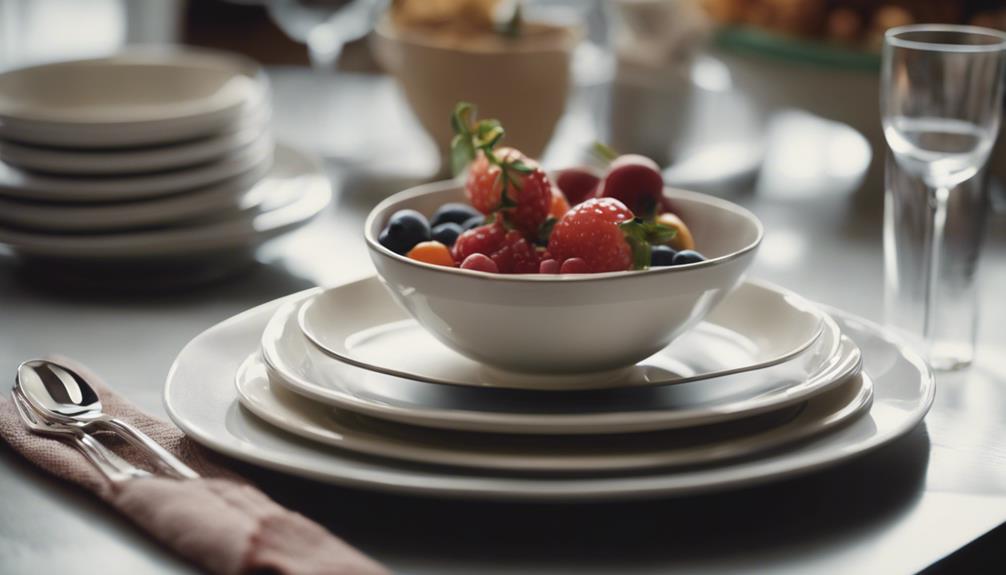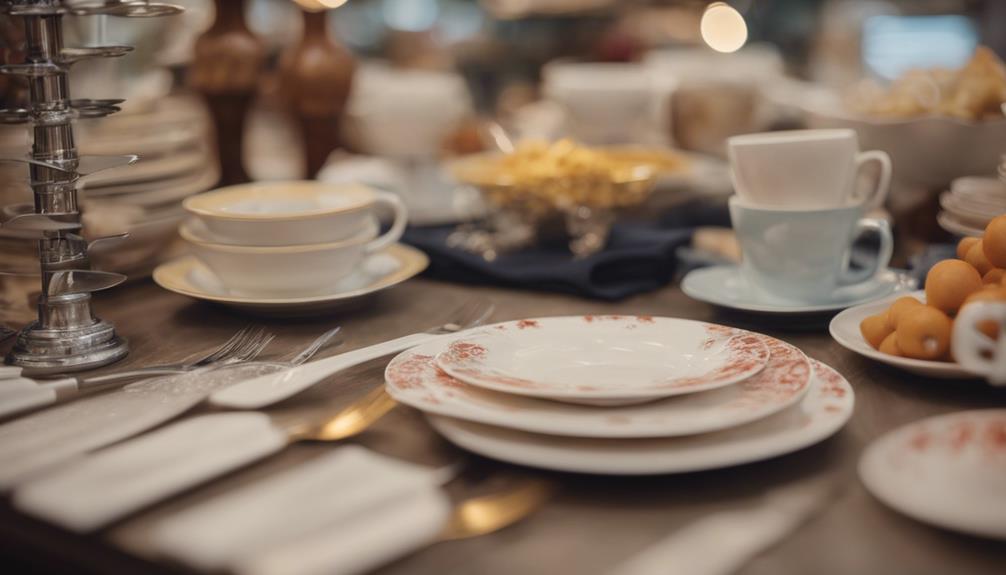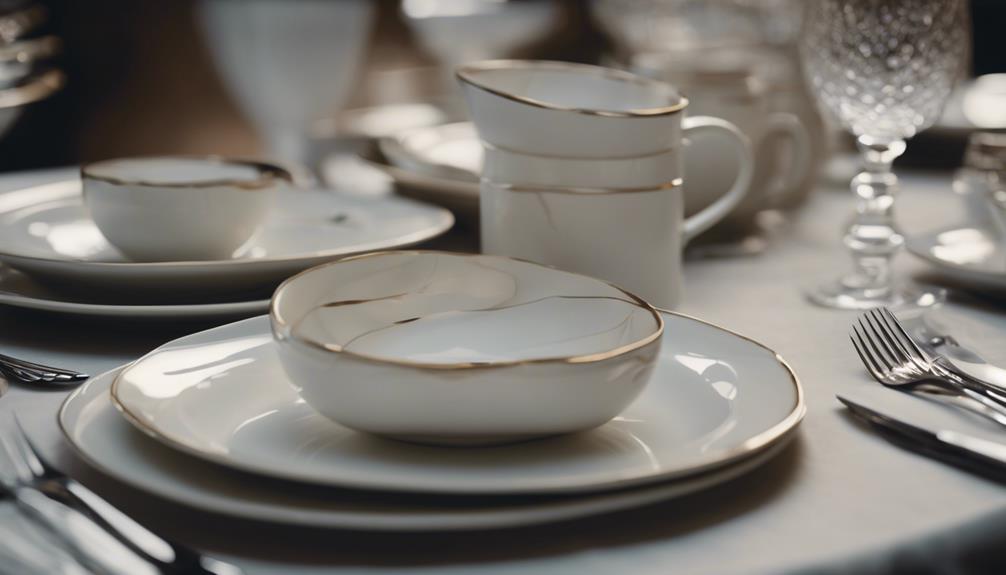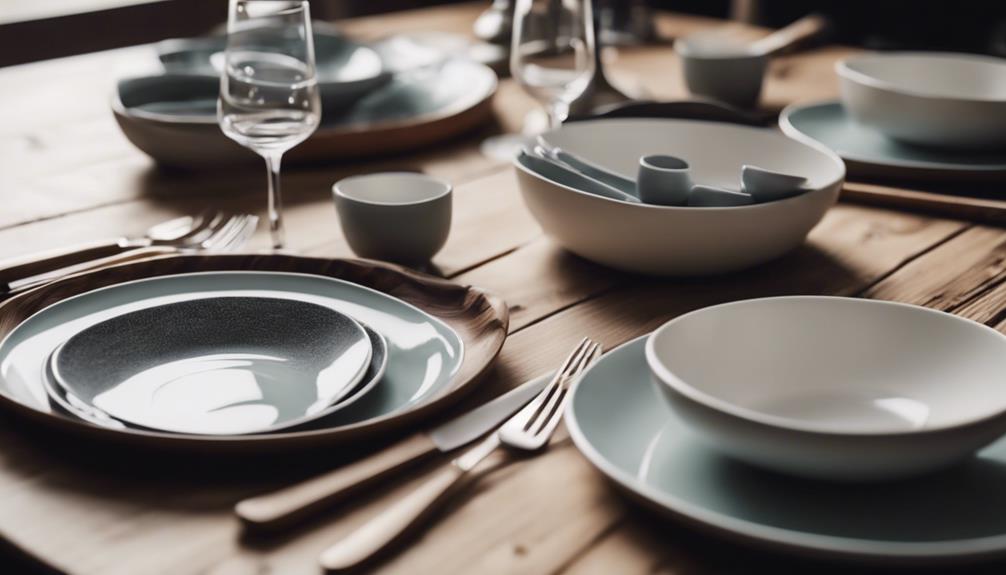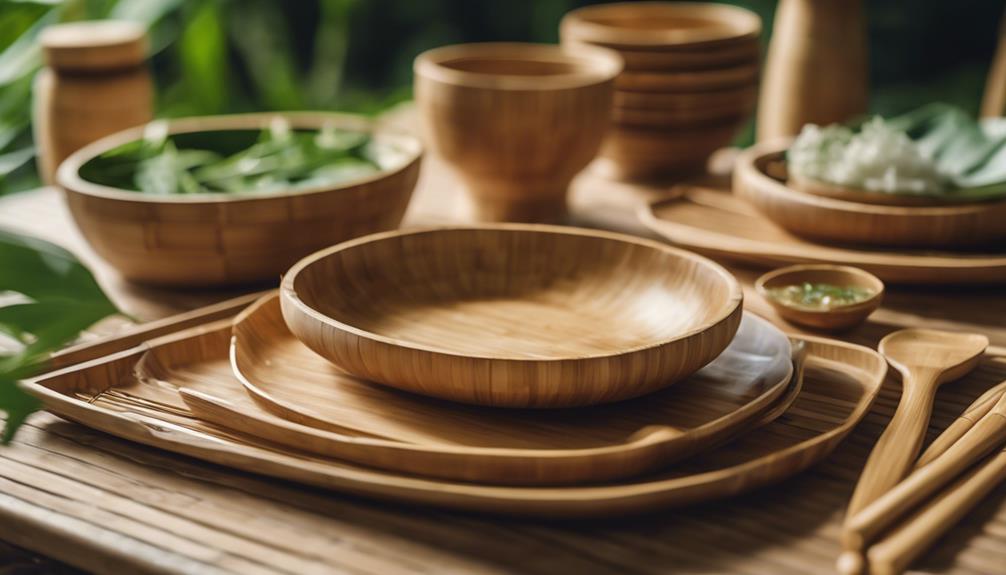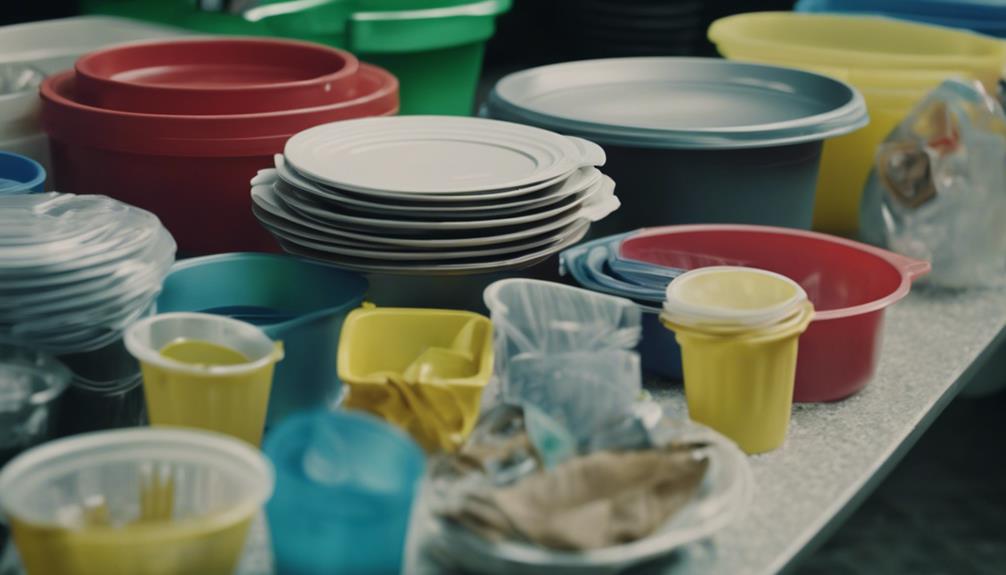Tableware includes utensils, dishware, and serving pieces used for dining and food presentation across various cultures. It encompasses a variety of materials, styles, and functions. From durable ceramics to strong stainless steel, tableware offers a wide range of options to suit different preferences. The historical use of precious metals like gold showcases its evolution. Plates, bowls, cutlery, and table decorations all play a role in enhancing dining experiences. Western, Chinese, and Japanese table settings display unique characteristics. Serving dishes and utensils such as platters and carving sets help make meal service more efficient. Tableware continues to evolve with new designs and technologies. Discover more about the fascinating world of tableware.
Key Takeaways
- Tableware refers to dishes, utensils, and serving pieces used for dining.
- It encompasses plates, cutlery, glasses, and other items for eating and serving food.
- Tableware includes a variety of materials like ceramic, metal, wood, and disposable options.
- These items are essential for setting a table and presenting food elegantly.
- Tableware enhances dining experiences and can vary in style and purpose.
Definition of Tableware
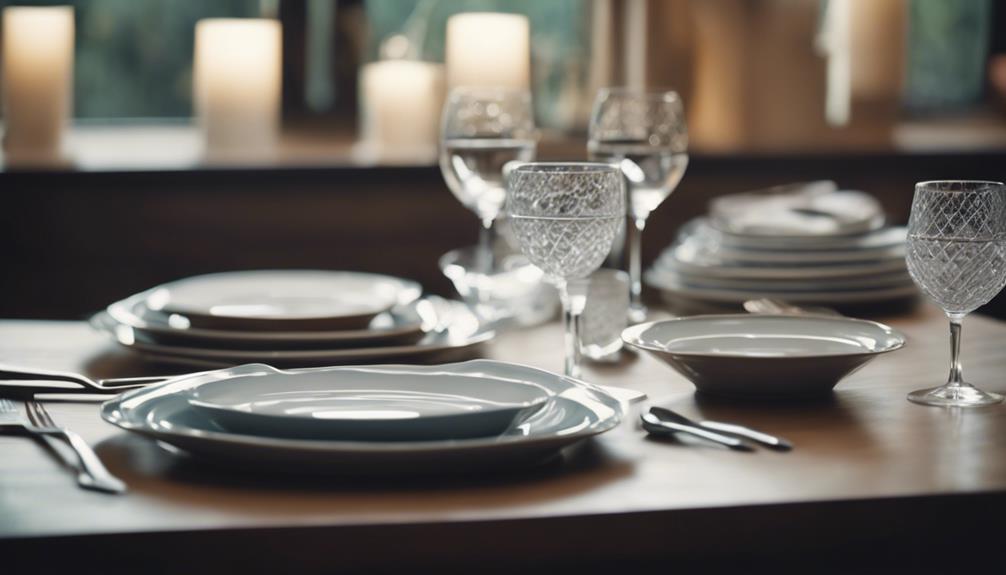
Tableware encompasses the essential dishes, utensils, and serving pieces required for setting a table and serving food. While kitchen utensils like spatulas and whisks are important for cooking, tableware specifically refers to items used during dining. Plates, glasses, knives, forks, and spoons are common examples of tableware. It's important to note that while kitchen utensils are necessary for food preparation, they don't fall under the category of tableware.
When setting the table for a meal, you'd typically use tableware such as plates for serving food, glasses for beverages, and utensils for eating. These items come in various materials like ceramic, glass, stainless steel, wood, and plastic. While kitchen utensils like measuring cups and cutting boards serve a different purpose, tableware enhances the dining experience. Remember, examples like ladles and tongs are kitchen utensils, not tableware.
Types of Tableware Materials
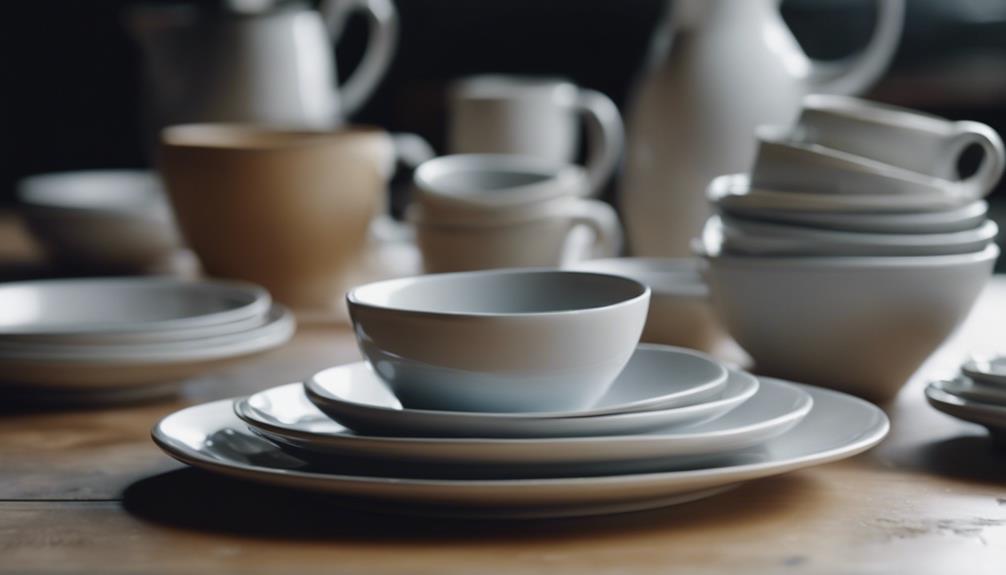
When it comes to tableware materials, various options are available to cater to different preferences and needs.
Ceramic materials like earthenware and porcelain offer durability and aesthetic appeal, while metals like stainless steel are known for their strength and resistance to corrosion.
Wood, glass, acrylic, and melamine are also popular choices, providing a diverse range of options for consumers to choose from.
Common Materials Used
Among the diverse array of materials utilized in tableware production, ceramic materials like earthenware, stoneware, bone china, or porcelain stand out for their durability and aesthetic appeal. Ceramic tableware is a popular choice due to its elegant look and resilience.
Apart from ceramics, materials such as wood, metals like pewter, tempered glass, acrylic, and melamine are also used to suit varied preferences. Stainless steel, known for its strength and corrosion resistance, is commonly used for cutlery in tableware sets.
Additionally, disposable tableware made from paper and plastic is prevalent, particularly with the growing global emphasis on sustainability. These materials cater to different needs and trends in the tableware industry, showcasing the versatility and adaptability of tableware production.
Pros and Cons
Utilizing ceramic materials in tableware offers a blend of durability and aesthetic appeal, making them a popular choice for both everyday use and special occasions. Ceramic tableware, such as earthenware, stoneware, bone china, or porcelain, is known for its elegance and resilience. However, ceramic items may be prone to chipping or breaking if mishandled.
Stainless steel, another common material in tableware, is favored for its strength, resistance to rust, and easy maintenance. On the downside, stainless steel can lack the warmth and charm of ceramic pieces.
Disposable tableware like paper and plastic is convenient but contributes to environmental issues. Other materials like wood, metals, tempered glass, acrylic, and melamine offer a diverse range of options to suit various preferences and requirements.
History of Tableware
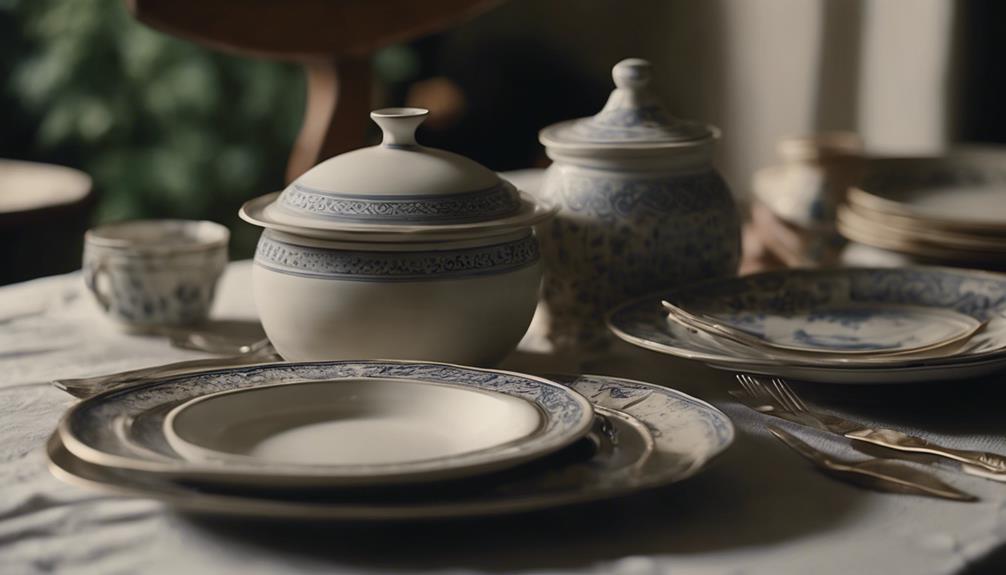
The history of tableware reflects a gradual shift from early pottery to more refined materials like gold and silver.
Trenchers, or bread rounds, were once the norm in medieval dining.
Ownership of elaborate tableware was a status symbol, often regulated by laws to maintain social distinctions.
Evolution of Tableware
During ancient times, the evolution of tableware saw a preference for precious metals like gold and silver among the elite for their flatware. As tableware progressed through history, various materials and styles emerged to meet different needs and preferences:
- Early pottery focused on creating pots and jars rather than flatware for tableware.
- Trenchers, bread rounds used as plates, were common in medieval cuisine as part of tableware.
- Tableware ownership was historically a symbol of wealth and status, regulated by sumptuary laws.
- Plate melting for financial reasons in the Middle Ages led to limited surviving examples of historical tableware.
Cultural Significance
As we explore the historical significance of tableware, it becomes evident that beyond their practical function, these objects carried profound cultural meanings and societal implications.
Early pottery primarily focused on pots and jars, with precious metals like gold and silver being favored by ancient elites for flatware. In medieval times, trenchers, bread rounds used as plates, were common in culinary settings. Owning tableware was a status symbol linked to wealth, often regulated by sumptuary laws.
The financial practice of melting plates resulted in limited surviving examples from the Middle Ages. The evolution of tableware reflects not only changes in dining habits but also the intricate connections between material culture, social hierarchy, and economic dynamics throughout history.
Plates and Vessels in Tableware
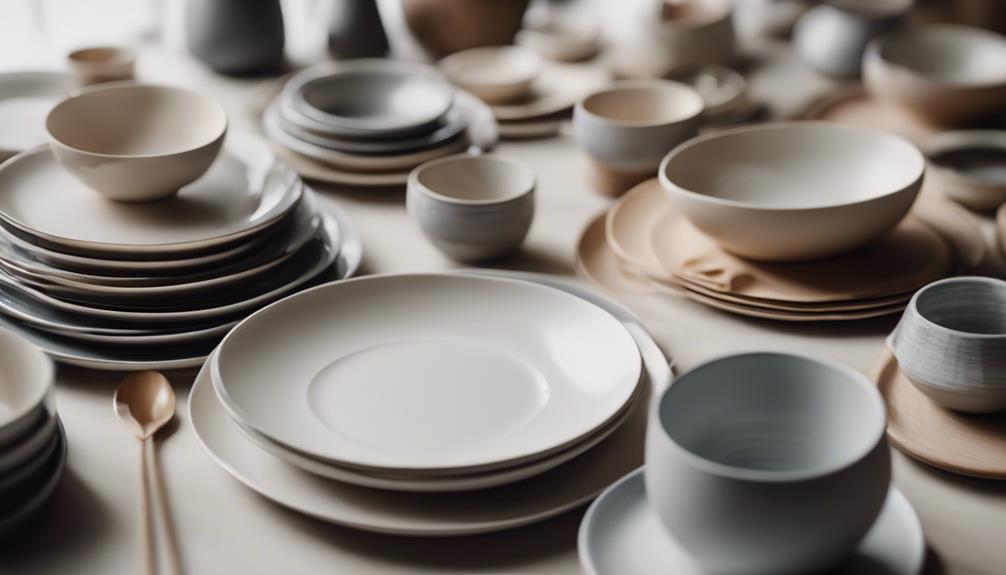
When setting a table, plates and vessels in tableware play a significant role in enhancing the dining experience. Here are five important points to take into account about plates and vessels in tableware:
- Variety: Tableware includes plates, bowls, cups, and other vessels used for serving and eating food, providing a wide range of options for different dining needs.
- Functionality: Plates can vary from dinner plates for main courses to salad plates for appetizers, catering to different serving requirements.
- Design: Vessels in tableware, such as serving bowls for salads or soups and cups for beverages, are designed to not only serve food but also enhance the overall dining experience.
- Presentation: Tableware vessels are crafted to complement the presentation of food, adding aesthetic appeal to the dining table.
- Versatility: The variety of plates and vessels in tableware allows for different styles of dining and serving options, making it versatile for various occasions and preferences.
Cutlery in Tableware

Cutlery in tableware, comprising knives, forks, and spoons, adds a touch of elegance and functionality to your dining experience. These essential utensils are crafted from a variety of materials like stainless steel, silver, or wood. In some regions, cutlery is referred to as silverware or flatware, showcasing cultural naming diversity.
The role of cutlery in table settings is vital, as it not only enhances the dining ambiance but also elevates the overall meal presentation. Depending on the formality of the occasion, the arrangement of cutlery can differ, with formal settings requiring specific placements for each piece.
Whether you're hosting a dinner party or enjoying a meal with your family, the right cutlery can make a significant difference in your dining experience. Choose cutlery that complements your tableware and reflects your personal style to create a memorable dining atmosphere.
Table Decoration Elements
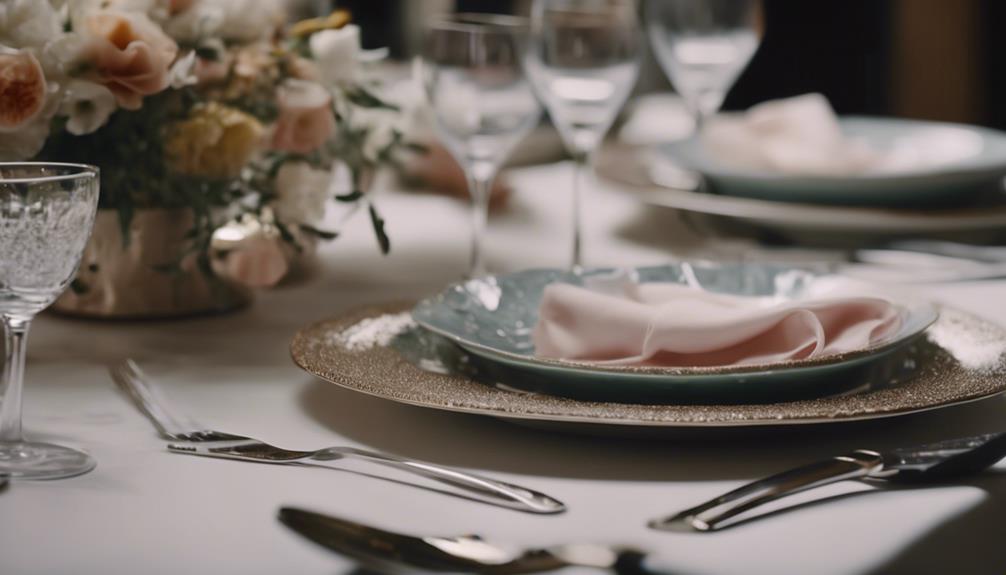
Enhance your dining experience by incorporating enchanting table decoration elements that blend functionality with aesthetics.
- Centerpieces: Elevate your table setting with a striking centerpiece that can range from floral arrangements to decorative sculptures.
- Place Cards: Add a personal touch to your table by using elegant place cards to assign seating for your guests.
- Candles: Create a cozy and inviting atmosphere with the warm glow of candles as part of your table decorations.
- Table Runners: Spruce up your table with a stylish table runner that complements the theme of your dining experience.
- Napkin Rings: Impress your guests by using decorative napkin rings to hold your napkins in elegant folds.
These elements not only enhance the visual appeal of your table but also contribute to the overall ambiance of the dining experience. By carefully selecting and arranging these decoration elements, you can create a memorable and aesthetically pleasing setting for your meals.
Western Style Table Settings
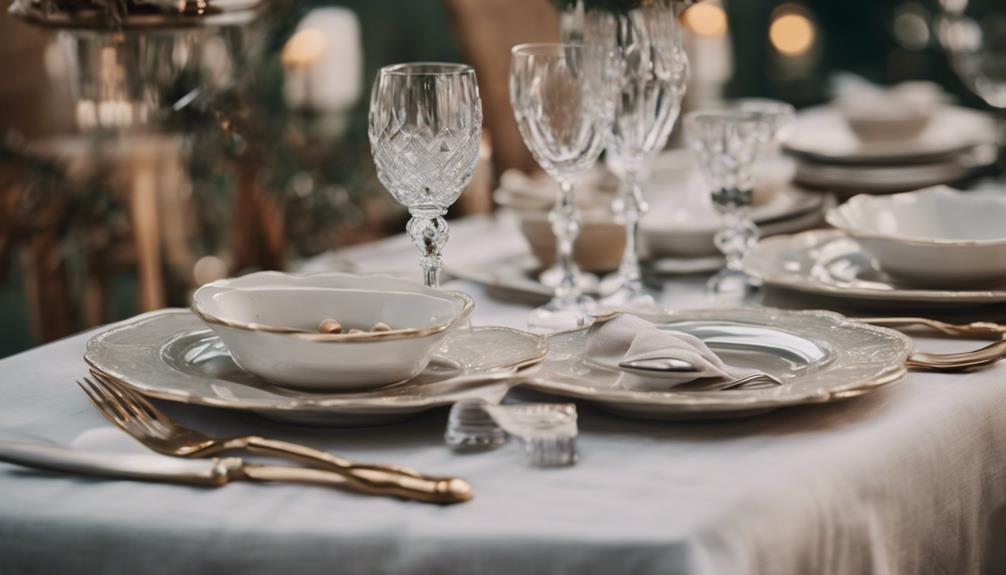
In Western table settings, understanding the distinct styles of service and placement rules for cutlery and dishes is essential for creating an elegant dining experience. Two main styles are service à la russe and service à la française, each with specific guidelines. Service à la russe organizes cutlery based on the number of courses served, with different glasses for water, red wine, and white wine. Traditional Western settings often include serving dishes like butter dishes and casseroles to enhance food presentation. Place markers aid in seating arrangements for a more organized dining experience. Various glasses, plates, and utensils are strategically placed to suit formal, casual, buffet, family-style, and banquet dining occasions.
| Style of Service | Cutlery Placement Rules | Dish Presentation |
|---|---|---|
| Service à la russe | Based on courses served | Butter dishes, casseroles |
| Service à la française | Fixed placement for each course served | Enhances food presentation |
Chinese and Japanese Tableware
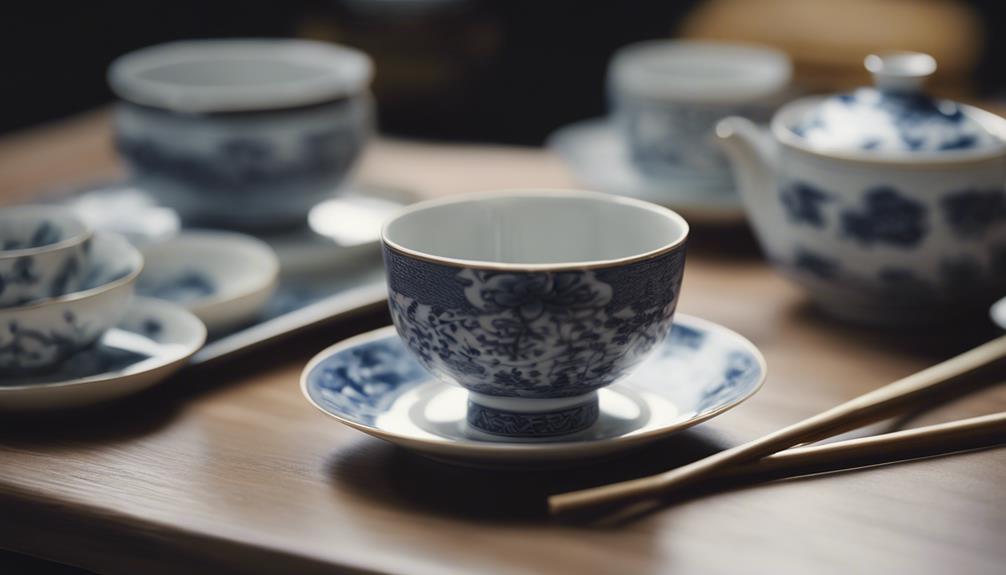
Chinese and Japanese tableware showcase distinct cultural aesthetics and materials, offering a unique dining experience compared to Western table settings.
- Chinese tableware often includes chopsticks, bowls, and plates made from materials like porcelain, bamboo, or lacquer.
- Japanese tableware features unique designs like sushi plates, teapots, and sake sets, often crafted from ceramics, porcelain, or wood.
- Chinese table settings may incorporate traditional symbols like dragons, phoenixes, or peonies for cultural significance.
- Japanese table settings reflect a minimalist aesthetic with clean lines and natural materials like wood and stoneware.
- Both Chinese and Japanese tableware emphasize the harmony of design elements, such as color, shape, and texture, to enhance the dining experience.
These tableware traditions not only serve practical purposes but also embody centuries-old cultural values, making each dining experience a blend of functionality and artistry.
Whether enjoying a meal with friends or family, the intricate details and thoughtful designs of Chinese and Japanese tableware can elevate the dining experience to a new level of appreciation for craftsmanship and culture.
Serving Dishes and Utensils
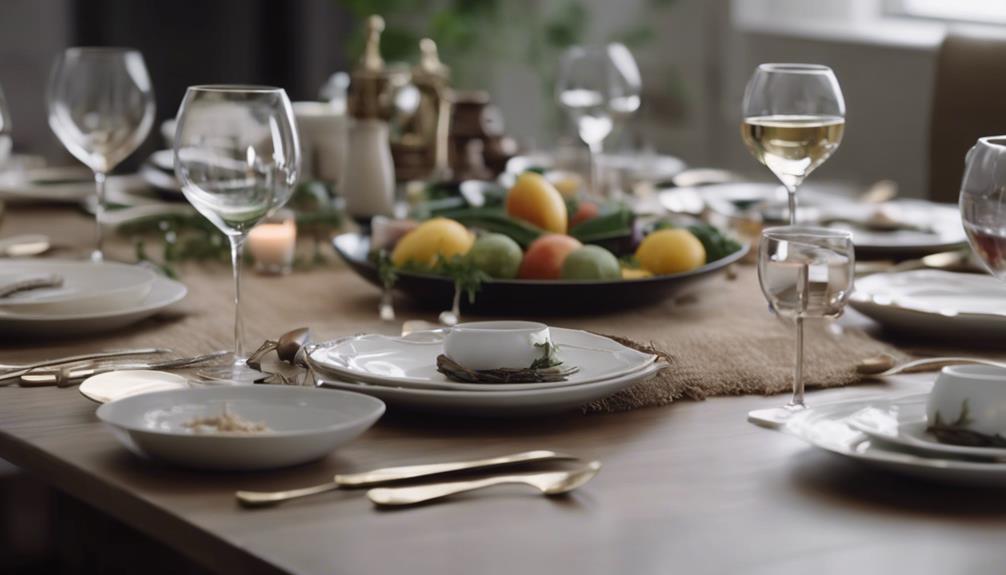
Serving dishes and utensils come in various types, serving different purposes during meals.
From platters for showcasing main dishes to ladles and tongs for serving, each utensil plays a specific role.
Understanding the uses of these items can enhance your dining experience and make serving food more efficient.
Types of Utensils
Enhance your table setting and dining experience with a variety of essential utensils like serving spoons, ladles, tongs, and carving sets in tableware setups. These utensils play an important role in presenting and serving food efficiently.
Here are some common types of utensils used in serving dishes and setups:
- Platters: Ideal for serving main dishes or appetizers.
- Serving Bowls: Perfect for salads, side dishes, or soups.
- Gravy Boats: Essential for pouring gravies and sauces.
- Casseroles: Great for baking and serving hot dishes.
- Carving Sets: Useful for slicing and serving meats or large roasts.
These utensils are designed to make serving food easier and more elegant, enhancing the overall dining experience.
Uses of Serving Dishes
With the right serving dishes and utensils, you can effortlessly elevate the presentation of your dishes and enhance the dining experience. Serving dishes are essential for presenting food elegantly, coming in various shapes, sizes, and materials like ceramic or glass. They add sophistication and visual appeal to meals, perfect for buffet-style dining, family gatherings, formal dinners, and special occasions.
These dishes play an important role in complementing the overall table setting and enhancing the dishes being served. Choosing the right serving dishes can make a significant difference in how your meals are perceived and enjoyed. Invest in quality serving dishes to create a memorable dining experience for you and your guests.
Tableware Adaptations
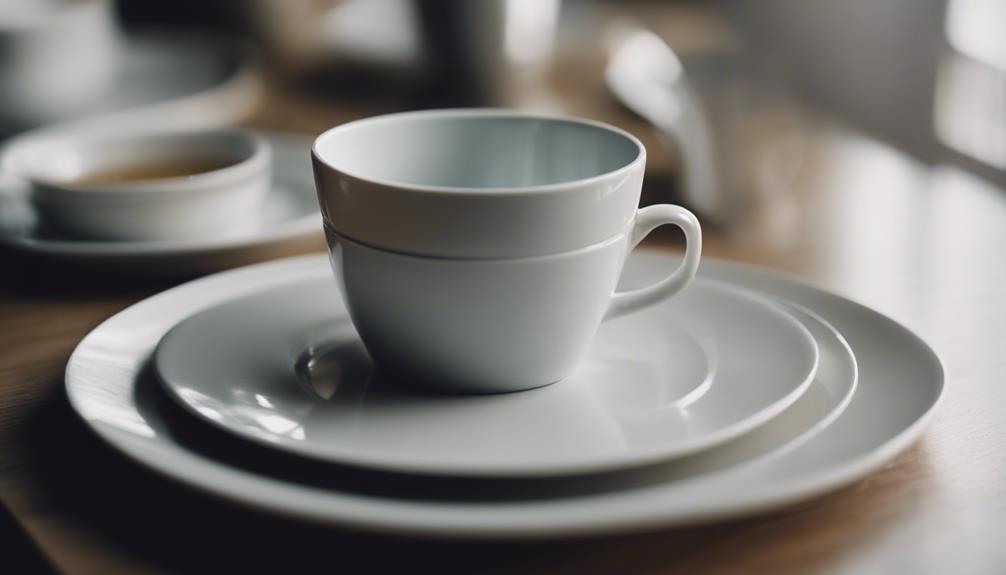
Tableware adaptations have revolutionized the traditional dining experience by incorporating cutting-edge technologies and sustainable practices. These advancements have brought about significant changes in the way we perceive and interact with tableware. Here are some key points to ponder:
- Industrial Applications: Tableware materials are now being repurposed for industrial uses, such as using ceramic printers to create innovative designs.
- Active and Aware Designs: New tableware designs are being developed to be active and aware objects, capable of responding to their environment.
- Eco-Friendly Practices: Biofuel production has introduced innovative ways to utilize tableware materials, promoting sustainability.
- Advanced Technology Integration: Tableware now features advanced technology, transforming them into functional and interactive pieces.
- Aesthetic and Functional Designs: Repurposing tableware materials has led to the creation of designs that blend aesthetics with functionality, meeting modern needs and preferences.
These adaptations showcase the versatility and potential of tableware beyond its traditional role, paving the way for a more dynamic dining experience.
Frequently Asked Questions
What Is Considered Tableware?
Tableware encompasses plates, glasses, knives, forks, and spoons for dining. Materials like ceramic, glass, stainless steel, wood, and plastic are commonly used. Table settings range from formal to casual, buffet to family-style.
Major brands include Wedgwood, Royal Doulton, Mikasa, Lenox, and Villeroy & Boch. Trends focus on minimalist designs, sustainable materials, mix-and-match styles, bold colors, and vintage-inspired pieces. These items enhance your dining experience and add style to your table setting.
What Are the Basic Types of Tableware?
When setting the table, you'll need essential tableware like plates, glasses, knives, forks, and spoons. These items serve both practical and aesthetic purposes, allowing you to enjoy meals with ease and style.
Materials such as ceramic, glass, stainless steel, wood, and plastic offer various options to suit your preferences. From formal to casual settings, tableware plays a vital role in enhancing your dining experience and presentation.
What's Another Word for Tableware?
When thinking about tableware, you might wonder, 'What's another word for tableware?'
Synonyms for tableware include dinnerware, dishes, crockery, and serveware. These terms encompass the plates, glasses, cutlery, and serving dishes used during dining.
Understanding these synonyms can help clarify the meaning of tableware in various dining and hospitality contexts. So, next time you set the table, remember these alternative names for your essential dining items.
What Is a Fancy Word for Plates and Bowls?
When it comes to fancy table settings, plates and bowls are often referred to as 'tableware.' This term covers all the items used for serving and enjoying your meals, from cups and saucers to serving dishes and utensils like knives, forks, and spoons.
Tableware can be crafted from various materials like ceramic, glass, stainless steel, wood, or plastic, adding a touch of elegance to your dining experience.
Conclusion
To sum up, tableware encompasses a wide range of items used for dining and serving food. From plates and cutlery to serving dishes and utensils, tableware plays an essential role in mealtime rituals around the world.
Whether you prefer Western style table settings or Chinese and Japanese traditions, the appropriate tableware can enhance your dining experience. As the saying goes, 'The table is a meeting place, a gathering ground, the source of sustenance and nourishment.'
Choose your tableware wisely and enjoy your meals in style.
